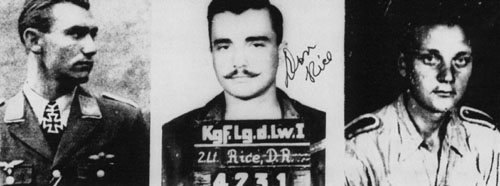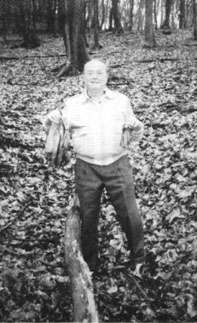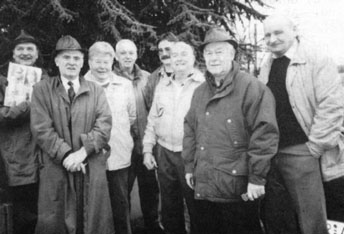The Short War of Don Rice
It is the 24th of February, 1944. The 357th Fighter Group has been operational for 14 days. It has flown six missions, three of them French coastal sweeps and three to German targets. The latter three brought contact with enemy fighters and resulted in the Group’s first victories, eleven of them. Six pilots were already gone — Giltner, Hubbard, Ross, Lichter, Boyle and Carroll. Two of them were dead, the others would return in 15 months or so.
The target on the 24th was Gotha, a short mission – only 4 hours. Two 190’s , a 109, a 110 and a rocket carrying JU 88 were shot down and tow pilots, Chuck McKee and Don Rice who did not return. At the end of the day, 362nd pilot Kenneth Hagan reported, “My wingman, Lt. Don Rice and I were flying together near Coblenz at an altitude of 24,000 feet, to the left rear and above a box of B-24s. Suddenly Lt. Rice called me and said that there were two bogies under us at one o’clock at about 10,000 feet. I made a turn to the left so that I could come down on them from the sun, Don remained during the turn. Immediately after the turn, I called Rice and told him that I couldn’t see the bogies anymore, that I was low on oxygen and that we better head home. I heard him say excitedly “they are 190’s”. I called him again and asked “are you with me Don?” There was only a garbled reply. Hagan did not see or hear Rice again, so tagged onto a couple of P-51s and come home.
15 months later, Don Rice carried on the story in his encounter report in which he claimed the destruction of an FW 190. “I started down in a split-ess and Hagan turned as though he were following me from the right. Getting close to the enemy plane, I noticed it had a yellow nose. In my dive, I had developed too much speed and although I retarded the throttle, I overshot him, but managed to get under him and when about 100 feet away, I opened fire with a 5 to 10 degree deflection. I observed strikes on his right wing root and all over the cockpit. I must have killed or wounded the pilot for the 190 suddenly nosed down and went straight into the ground. The pilot had not bailed out. Climbing back upstairs, I called Lt. Hagan, but just then I was shot down from behind by another 190. I was able to bail out but broke my leg in trying to extricate myself from a tree in which I had landed. The Germans found me and I have been a POW until recently.”
The aerial battles that swirled above them were of great interest to a generation of German boys, just as they had been to a similar group across the English Channel during the day s of the Battle of Britain. Many of the youngsters on both sides were lucky enough to be just young enough to avoid getting caught up in a savage war as participants.
Erich Pfarr was one of those on the ground that day and he remembers. He said it was his last year in school being born in 1929. It was a sunny cold day, cloudless sky with 8 to 12 inches of snow. they had expected an air raid which came about 11:30 but the alarm came too late because the bombers were already above them on their way home. There was an intense fight above them and then everything happened fast. Parachutes flew above them in a westerly direction. Suddenly there were increasingly louder motor noises, a big bang, a smoke plume and one pilot in a parachute. It was the crash of a U.S. Jaeger (fighter) north of Unterbreizbach. The pilot landed near the Ulster Bridge, badly injured. A four motor bomber flew lower in a line from the south toward the Ulsterberg, and crashed in the woods.
Almost 50 years later, another German, Heinz Jirousek who had been about 4 years old in 1944, now an avid researcher of the vicious battles, located the wreckage of Rice’s plane. He also managed to track down Erich Pfarr (quoted above) and other witnesses and to identify the German pilots involved. The following was sent to both Don Rice and Merle Olmsted which is included here courtesy of Mr. Jirousek. “What a day today”, Peter Gottbehut recalls, “the whole morning bomber streams going eastward.” Now at 1340 hours, they come back just over our little village of Rott. Everybody was standing outside counting the little shining points with contrails. One hundred, tow hundred and more. A big deep roar was in the air, you could feel it in your stomach. Suddenly from the east just over the top of a hill, a four engine bomber showed up, very low and aflame. Everybody was running for cover, like chickens hunted by a hawk. The bomber, a B-17 crashed just behind the houses in a small strip of woods with a huge explosion. We took a deep breath and came back on our feet again but a new noise made us freeze. A fighter plane with great engine noise came out of the sky. It crashed only a few miles from us in a hillside. A parachute was seen floating down. Everybody started to run to the scene of the crash.
As Rice indicated in his own narrative, he broke his leg getting out of the tree. He was then carried from the woods to the road by workers from an iron mine where he was picked up by a German farmer named Seul and taken to his farm. That same evening, a care from Neuwied took him to the Garrison Hospital in that town.
The German pilot who shot Rice down was Oberleutnant (1st Lt.) Waldi Radener, the commander of the 7th Staffel of JG 26. By the end of the war, he had 36 victories of which 17 were 4 engine bombers. After the war, he joined the new German Air Force, only to be the first air victim of the new Luftwaffe. He was killed in a crash on 8 Jan. 1957.
Heinz Jirousek has concluded that the FW 190 shot down by Rice was flown by Unteroffizier (NCO) Gerhard Loschinski, also of JG 26, who was killed. At the time he had flown 10 missions and had one victory to his credit.

(L-R) Oberleutnant Waldi Radener, Lt. Don Rice, Unteroffizer Gerhard Locschinski
Don Rice’s missing Aircrew Report contains translations of several German documents including the following: “The American Air Corps member Lt. Don Rice, reported by letter of 24 Feb 1944, has escaped through the barred window of an especially fit room for the purpose on March 24, 1944 at about 3 o’clock. Endeavors to recapture the prisoner have been started already by the local commander at Neuwied.” Rice was indeed soon recaptured and spent the rest of the war at Stalag Luft I, at Barth in Northern Germany. Heinz Jirousek has invited Rice to visit him in Germany and plans have been made to do so early in 1994. On the 24th of February, Don plans to be standing on the spot on which he landed 50 years ago to the day, after his SHORT WAR.

Don Rice (50 years later) standing in the hole that was created when his aircraft buried itself into the ground. Pieces of aluminum metal from the aircraft are still at the site.
Short War Follow Up
Don Rice did go to Germany the last tow weeks of February and the first tow weeks of March, 1994. don met Mr. Heinz Jerousek and two of his friends who are also very interested in tracing various airplane crashes during WWII. Mr. Jerousek arranged to have Don picked up at his hotel in Frankfurt and driven to his home. From his home, he took Don to another friends home who had a large collection of souvenirs from various crashes. This friend ha a 20 MM Cannon from a German ;lane, a 50 Ca. Machine fun from an American plane, plus several propeller blades of all kinds It was like a small museum. After having lunch at his friends house, they all (5) drove to the vicinity of the crash site of Don’s P-51. When they got there, they met 4 local citizens who had heard about Don’s coming and they joined the others for the walk through the woods to the crash site itself. Don had several pictures taken. One of the locals said that he remembers seeing and hearing Don’s plane before it crashed but he did not see Don’s parachute.
Every German at the scene was extremely friendly and made Don feel more like a long lost buddy rather that a former enemy. One of the locals produced small bottles of “snaps” and they toasted to friendship, no more wars. They all agreed that America saved Germany and were very grateful for our help.
Heinz Jerousek gave Don the name of the German who shot him down. His name was Oberleutnant Woldermar Radener. He was killed in a T-6 during a training flight Jan 8, 1957. He was the first casualty in the post war Luftwaffe. He had 37 victories to his credit.
The name of the pilot Don shot down during this same encounter was Unteroffizzeer Gerhard Loschinski who had 10 missions and 1 victory. His plane dove straight into the ground and his remains were dug up just 5 years ago and interred in a military cemetery. He had been buried for 45 years before he was dug up.
Heinz told Don that he had recovered and identified a pilot of a P-47 shortly before Don’s arrival. He turned the remains over to the U.S. Armed Forces. The pilot had been carried as MIA all of these past years. Heinz gave Don a great memento of Don’s airplane consisting of the tip of the horizontal stabilizer along with a Mfg. plate from the oil filter plus one of the actual 50 cal. bullets he had recovered from the crash site.

Don’s German friends. Heinz Jerousek is 4th from the left. Don Rice is 3rd from the right.
This article put together by Merle Olmsted for the 357th FG Association Newsletter.

